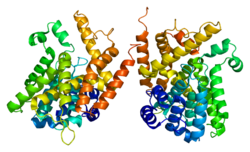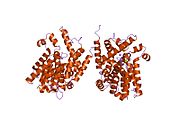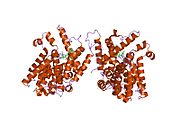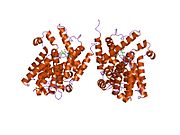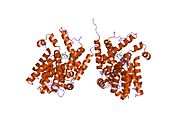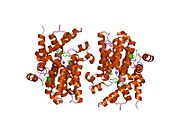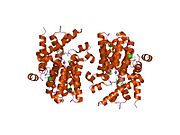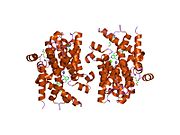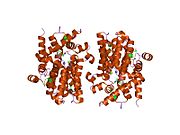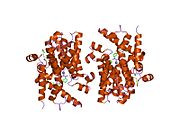PDE4B
cAMP-specific 3',5'-cyclic phosphodiesterase 4B is an enzyme that in humans is encoded by the PDE4B gene.[5]
This gene is a member of the type IV, cyclic AMP (cAMP)-specific, cyclic nucleotide phosphodiesterase (PDE) family. Cyclic nucleotides are important second messengers that regulate and mediate a number of cellular responses to extracellular signals, such as hormones, light, and neurotransmitters. The cyclic nucleotide phosphodiesterases (PDEs) regulate the cellular concentrations of cyclic nucleotides and thereby play a role in signal transduction. This gene encodes a protein that specifically hydrolyzes cAMP. Alternate transcriptional splice variants, encoding different isoforms, have been characterized.[5][6]
Clinical relevance
Altered activity of this protein has been associated with schizophrenia and bipolar disorder.[5] PDE4B is believed to be the PDE4 subtype involved in the antipsychotic effects of PDE4 inhibitors such as rolipram.[7] PDE4B is involved in dopamine-associated and stress-related behaviours.[8] It has also recently been implicated in Alzheimer's disease.[9]
Inhibitors
AN2728, a boron-containing drug candidate that as of 2015 was under development by Anacor Pharmaceuticals for the topical treatment of psoriasis and atopic dermatitis (atopic eczema).[10][11][12] mainly acting on PDE4B.[12]
References
- ^ a b c GRCh38: Ensembl release 89: ENSG00000184588 – Ensembl, May 2017
- ^ a b c GRCm38: Ensembl release 89: ENSMUSG00000028525 – Ensembl, May 2017
- ^ "Human PubMed Reference:". National Center for Biotechnology Information, U.S. National Library of Medicine.
- ^ "Mouse PubMed Reference:". National Center for Biotechnology Information, U.S. National Library of Medicine.
- ^ a b c "Entrez Gene: PDE4B phosphodiesterase 4B, cAMP-specific (phosphodiesterase E4 dunce homolog, Drosophila)".
- ^ Swerdlow, Neal R. (2010-08-19). Behavioral Neurobiology of Schizophrenia and Its Treatment. Springer Science & Business Media. ISBN 9783642137174.
- ^ Porteous DJ, Millar JK, Brandon NJ, Sawa A (Dec 2011). "DISC1 at 10: connecting psychiatric genetics and neuroscience". Trends in Molecular Medicine. 17 (12): 699–706. doi:10.1016/j.molmed.2011.09.002. PMC 3253483. PMID 22015021.
- ^ Phosphodiesterases as Drug Targets (PDF). Handbook of Experimental Pharmacology. Vol. 204. Springer Berlin Heidelberg. 2011. doi:10.1007/978-3-642-17969-3. ISBN 978-3-642-17968-6.
{{cite book}}: Unknown parameter|editors=ignored (|editor=suggested) (help) - ^ http://newsdaily.com/2015/08/scientists-researching-brain-disorders-create-super-clever-mice/
- ^ Anacor AN2728 at Anacor website Page accessed May 15, 2015
- ^ Nazarian R, Weinberg JM (Nov 2009). "AN-2728, a PDE4 inhibitor for the potential topical treatment of psoriasis and atopic dermatitis". Current Opinion in Investigational Drugs. 10 (11): 1236–42. PMID 19876791.
- ^ a b Moustafa F, Feldman SR (May 2014). "A review of phosphodiesterase-inhibition and the potential role for phosphodiesterase 4-inhibitors in clinical dermatology". Dermatol Online J. 20 (5): 22608. PMID 24852768.
Further reading
- Szpirer C, Szpirer J, Rivière M, Swinnen J, Vicini E, Conti M (1995). "Chromosomal localization of the human and rat genes (PDE4D and PDE4B) encoding the cAMP-specific phosphodiesterases 3 and 4". Cytogenetics and Cell Genetics. 69 (1–2): 11–4. doi:10.1159/000133927. PMID 7835077.
- Bolger GB, Rodgers L, Riggs M (Nov 1994). "Differential CNS expression of alternative mRNA isoforms of the mammalian genes encoding cAMP-specific phosphodiesterases". Gene. 149 (2): 237–44. doi:10.1016/0378-1119(94)90155-4. PMID 7958996.
- Milatovich A, Bolger G, Michaeli T, Francke U (Mar 1994). "Chromosome localizations of genes for five cAMP-specific phosphodiesterases in man and mouse". Somatic Cell and Molecular Genetics. 20 (2): 75–86. doi:10.1007/BF02290677. PMID 8009369.
- McLaughlin MM, Cieslinski LB, Burman M, Torphy TJ, Livi GP (Mar 1993). "A low-Km, rolipram-sensitive, cAMP-specific phosphodiesterase from human brain. Cloning and expression of cDNA, biochemical characterization of recombinant protein, and tissue distribution of mRNA". The Journal of Biological Chemistry. 268 (9): 6470–6. PMID 8384210.
- Obernolte R, Bhakta S, Alvarez R, Bach C, Zuppan P, Mulkins M, Jarnagin K, Shelton ER (Jul 1993). "The cDNA of a human lymphocyte cyclic-AMP phosphodiesterase (PDE IV) reveals a multigene family". Gene. 129 (2): 239–47. doi:10.1016/0378-1119(93)90274-7. PMID 8392015.
- Bolger G, Michaeli T, Martins T, St John T, Steiner B, Rodgers L, Riggs M, Wigler M, Ferguson K (Oct 1993). "A family of human phosphodiesterases homologous to the dunce learning and memory gene product of Drosophila melanogaster are potential targets for antidepressant drugs". Molecular and Cellular Biology. 13 (10): 6558–71. doi:10.1128/mcb.13.10.6558. PMC 364715. PMID 8413254.
- Huston E, Lumb S, Russell A, Catterall C, Ross AH, Steele MR, Bolger GB, Perry MJ, Owens RJ, Houslay MD (Dec 1997). "Molecular cloning and transient expression in COS7 cells of a novel human PDE4B cAMP-specific phosphodiesterase, HSPDE4B3". The Biochemical Journal. 328 (Pt 2): 549–58. doi:10.1042/bj3280549. PMC 1218954. PMID 9371714.
- Ma D, Wu P, Egan RW, Billah MM, Wang P (Jan 1999). "Phosphodiesterase 4B gene transcription is activated by lipopolysaccharide and inhibited by interleukin-10 in human monocytes". Molecular Pharmacology. 55 (1): 50–7. PMID 9882697.
- Secchiero P, Zella D, Curreli S, Mirandola P, Capitani S, Gallo RC, Zauli G (Dec 2000). "Pivotal role of cyclic nucleoside phosphodiesterase 4 in Tat-mediated CD4+ T cell hyperactivation and HIV type 1 replication". Proceedings of the National Academy of Sciences of the United States of America. 97 (26): 14620–5. doi:10.1073/pnas.011512398. PMC 18968. PMID 11114167.
- Zauli G, Milani D, Mirandola P, Mazzoni M, Secchiero P, Miscia S, Capitani S (Feb 2001). "HIV-1 Tat protein down-regulates CREB transcription factor expression in PC12 neuronal cells through a phosphatidylinositol 3-kinase/AKT/cyclic nucleoside phosphodiesterase pathway". FASEB Journal. 15 (2): 483–91. doi:10.1096/fj.00-0354com. PMID 11156964.
{{cite journal}}: CS1 maint: unflagged free DOI (link) - Moon E, Lee R, Near R, Weintraub L, Wolda S, Lerner A (Feb 2002). "Inhibition of PDE3B augments PDE4 inhibitor-induced apoptosis in a subset of patients with chronic lymphocytic leukemia". Clinical Cancer Research. 8 (2): 589–95. PMID 11839681.
- Shepherd M, McSorley T, Olsen AE, Johnston LA, Thomson NC, Baillie GS, Houslay MD, Bolger GB (Mar 2003). "Molecular cloning and subcellular distribution of the novel PDE4B4 cAMP-specific phosphodiesterase isoform". The Biochemical Journal. 370 (Pt 2): 429–38. doi:10.1042/BJ20021082. PMC 1223190. PMID 12441002.
- Arp J, Kirchhof MG, Baroja ML, Nazarian SH, Chau TA, Strathdee CA, Ball EH, Madrenas J (Nov 2003). "Regulation of T-cell activation by phosphodiesterase 4B2 requires its dynamic redistribution during immunological synapse formation". Molecular and Cellular Biology. 23 (22): 8042–57. doi:10.1128/MCB.23.22.8042-8057.2003. PMC 262363. PMID 14585965.
- Brandenberger R, Wei H, Zhang S, Lei S, Murage J, Fisk GJ, Li Y, Xu C, Fang R, Guegler K, Rao MS, Mandalam R, Lebkowski J, Stanton LW (Jun 2004). "Transcriptome characterization elucidates signaling networks that control human ES cell growth and differentiation". Nature Biotechnology. 22 (6): 707–16. doi:10.1038/nbt971. PMID 15146197.
- Smith PG, Wang F, Wilkinson KN, Savage KJ, Klein U, Neuberg DS, Bollag G, Shipp MA, Aguiar RC (Jan 2005). "The phosphodiesterase PDE4B limits cAMP-associated PI3K/AKT-dependent apoptosis in diffuse large B-cell lymphoma". Blood. 105 (1): 308–16. doi:10.1182/blood-2004-01-0240. PMID 15331441.
- Ballif BA, Villén J, Beausoleil SA, Schwartz D, Gygi SP (Nov 2004). "Phosphoproteomic analysis of the developing mouse brain". Molecular & Cellular Proteomics. 3 (11): 1093–101. doi:10.1074/mcp.M400085-MCP200. PMID 15345747.
{{cite journal}}: CS1 maint: unflagged free DOI (link) - Millar JK, Pickard BS, Mackie S, James R, Christie S, Buchanan SR, Malloy MP, Chubb JE, Huston E, Baillie GS, Thomson PA, Hill EV, Brandon NJ, Rain JC, Camargo LM, Whiting PJ, Houslay MD, Blackwood DH, Muir WJ, Porteous DJ (Nov 2005). "DISC1 and PDE4B are interacting genetic factors in schizophrenia that regulate cAMP signaling". Science. 310 (5751): 1187–91. doi:10.1126/science.1112915. PMID 16293762.
- Kimura K, Wakamatsu A, Suzuki Y, Ota T, Nishikawa T, Yamashita R, Yamamoto J, Sekine M, Tsuritani K, Wakaguri H, Ishii S, Sugiyama T, Saito K, Isono Y, Irie R, Kushida N, Yoneyama T, Otsuka R, Kanda K, Yokoi T, Kondo H, Wagatsuma M, Murakawa K, Ishida S, Ishibashi T, Takahashi-Fujii A, Tanase T, Nagai K, Kikuchi H, Nakai K, Isogai T, Sugano S (Jan 2006). "Diversification of transcriptional modulation: large-scale identification and characterization of putative alternative promoters of human genes". Genome Research. 16 (1): 55–65. doi:10.1101/gr.4039406. PMC 1356129. PMID 16344560.

